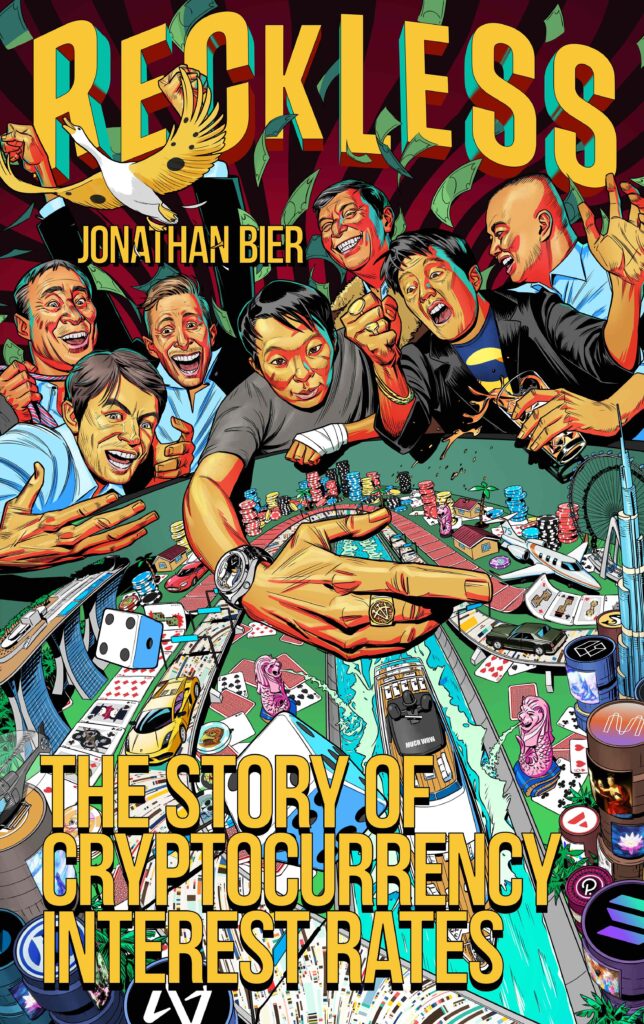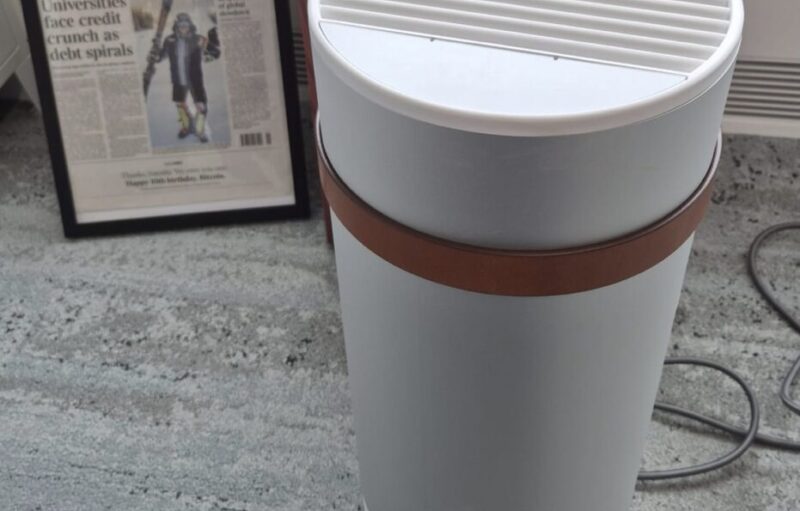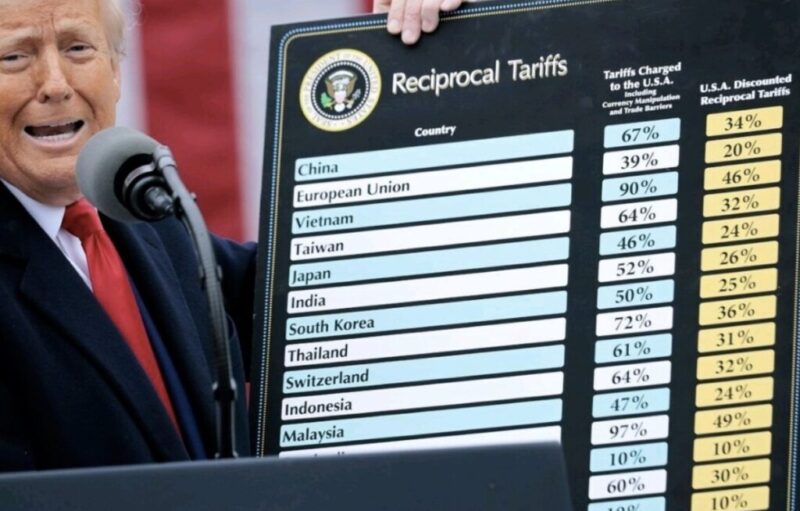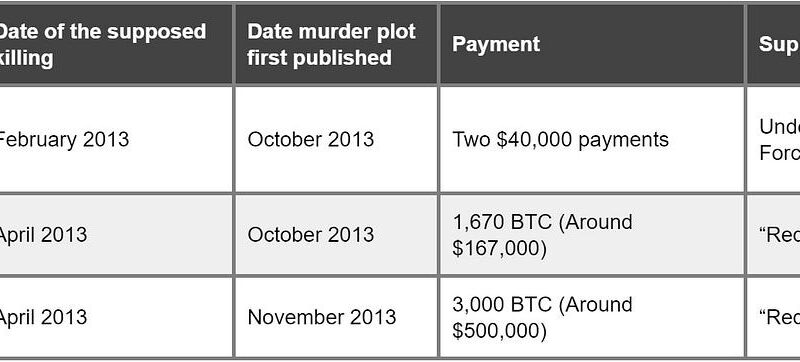Chapter 5 of the book Reckless: The Story Of Cryptocurrency Interest Rates is published below. The full book is available on Amazon. The book was written before the bankruptcy of FTX and therefore does not include coverage of this event. However, the book does provide useful commentary in the run up to the failure of FTX, which provides context for the eventual calamity.

After the 2008 financial crisis, perhaps as a result of the monetary policy enacted in response to it, the prices of a whole range of assets soared. This is sometimes referred to as the everything bubble. In 2000 it was technology stocks, in 2008 it was primarily housing and by this third wave of lower interest rates, it was pretty much absolutely every asset with a price.
The first major bubble post the global financial crisis was in commodities. Some rare earth metals rallied up to 4,000% between January 2010 and the peak at the end of May 2011. These metals such as cerium, praseodymium and europium were said to be powering new technology such as iPhones and would be hoarded by the Chinese government as a key strategic asset. Gold rallied 181% from its post-financial crisis low to US$1,921 a troy ounce by its 2011 high, as the unprecedented easing undermined the integrity of fiat money. In the eyes of some investors gold was still seen as an alternative to fiat paper money. Silver also enjoyed a massive run, up 489% from its post-financial crisis low to almost US$50 a troy ounce by May 2011. Agricultural commodities saw a boom too, corn increased in value by 191% from its post-financial crisis low to its peak in 2012. Oil also enjoyed a similar boom in the period, rallying 185%.
These commodity bubbles fizzled out and prices crashed between mid-2011 to 2012. Improving technology in mining and large capital investments in production capacity pre the global financial crisis, ensured production growth and therefore the supply of the commodities was strong. At the same time, commodities, traditionally a good area for bubbles, didn’t really capture the imagination of millennials or the zeitgeist of the time. In contrast, the areas highlighted and discussed below, enjoyed a sensational bubble that in some form or another, persisted up until 2021. In some cases, these bubbles lasted over 10 years.
Everything Bubble Indicators & Examples
Loss making IPOs – By 2018 the percentage of IPOs consisting of unprofitable companies listing on public markets reached a record high of over 80%. Re-taking the previous high in the 1999 technology bubble. This compares to a low of around 30% in 2009. With interest rates near zero, short term profitability mattered less and less to investors, who were instead focused on the long-term growth prospects.
FAANGs – FAANG stands for Facebook, Apple, Amazon, Netflix and Google. Examples of exceptionally strong and dominant technology companies, with good growth prospects. Due to the almost monopoly position of each of these companies, they were said to be unstoppable and would continue to grow into perpetuity. Conventional wisdom was that it did not matter what price you invested in these stocks, as the growth would eventually catch up with you. Apple, the most valuable company of the five, became the world’s first trillion dollar company in August 2018. Then two years later it achieved a two trillion dollar valuation, before finally, in January 2022, breaching the three trillion dollar mark.
Buybacks – With money so cheap, it made sense for corporations to borrow. One thing they did with the money is buy back their own stock. In 2021 S&P 500 companies purchased a record US$881.7 billion of their own stock, a 69.6% increase from the $519.8 billion in 2020. Some companies, such as Intel and IBM, were accused of spending too much money on buybacks, rather than investing in technology, resulting in a weaker strategic position.
Corporate Debt – In 2020 US non-financial corporate debt reached US$27.7 trillion, a record high and up 9.2% compared to 2020. This compares to total US corporate debt of around US$10 trillion before the 2008 global financial crisis.
Real Estate – Real estate markets around the world also reacted positively to financial conditions. The boom was global, with cities such as New York, London, Sydney, Vancouver and Hong Kong seeing strong price appreciation in the value of property, in particular the prime sectors. The London house price index increased by 114% between the 2009 low and 2022.
Art – Art prices also reached record highs. At the time of writing, every one of the fifteen most expensive paintings ever sold, in official inflation adjusted dollars, occurred after the 2008 financial crisis. Auction house Sotheby’s generated US$7.3 billion of revenues in 2021, a record high, up 46% YoY.
Startups – The post crisis period was one of extraordinary success for startups and venture capital investors. Venture capital funds such as Andreessen Horowitz, Sequoia Capital, Kleiner Perkins, Accel, Index Ventures, Lightspeed Ventures, Greylock Partners were the new masters of the universe, replacing investment banks from the pre-crisis era. They were the new Goldman Sachs, where all the graduates wanted to go to make money. The VC firms tend to operate as a pack, all competing with each other over deal flow, keen to be first into the next big thing. Raising money as a technology startup was never easier, if one had the right connections. One just needed the ability to sell a dream. The firms never even needed to make profits in order for the VC funds to capitalise on it, they could just keep raising more VC money in more rounds at higher valuation points and then eventually conduct a loss-making IPO. In 2021, US$330 billion of VC money was invested in the United States, up 99% YoY and up almost 1,200% since 2009. There is also significant “dry powder” remaining for new investments, American VC funds are said to currently be sitting on US$230 billion of capital.
Concept stocks – The valuations of companies that capture the public imagination of the future, reached astronomical levels. Some examples of these concepts and ideas, along with the associated stocks, are listed below:
- Electric cars (Tesla, Nicola)
- Electric car batteries (CATL)
- Robotics (Teradyne)
- Home sharing (AirBnB)
- Food delivery (Deliveroo)
- Office space (WeWork)
- Ride sharing companies (Uber, Lyft)
- Cannabis legalisation (Curaleaf, Sundial Growers)
- E-cigarettes (Zandera, CN Creative)
- Fake meat (Beyond Meat)
- Home exercising (Peloton)
- Zero fee stock trading (Robinhood)
- Blockchains (Marathon Digital, Bakkt)
Meme stocks – The meme stock craze, where trading in a particular name becomes popular through social media, such as the subreddit /r/wallstreetbets, started in 2021. The meme stock phenomena is characterised by young traders, who are not financial professionals, investing in a stock or its call options, without any consideration for its valuation. The traders are often looking for stocks where large short positions exist, such that a short squeeze can occur and the stock rally can therefore be especially frenetic. This famously happened to Gamestop. Other names impacted by this are the cinema chain AMC and Bed, Bath & Beyond. From the start of 2021 to its peak less than a month later, Gamestop appreciated in price by over 2,330%.
Cryptocurrency – At perhaps the epicentre of the bubble was the world of cryptocurrency. Bitcoin itself had a series of four fantastic rallies in 2011, 2013, 2017 and 2021. However, this is only the tip of the iceberg with respect to the insanity and outrageous valuations in the cryptocurrency space. From “The DAO” (Decentralised Autonomous Organisation) in 2016, to the 2017 ICO boom, the 2017 chain splits which generated value out of nothing, the 2021 DeFi governance token boom, the 2021 food token boom, the re-emergence of DAOs in 2021 and the dog coin bubble. Then there is the high yield cryptocurrency stablecoin and lending markets, designed to capitalise on these booms, which is a topic extensively covered later in this book.
NFTs – In 2021 there was a massive boom in the prices and trading volume of non-fungible tokens. These tokens which exist on blockchains, such as Ethereum, are typically associated with an image file. In March 2021 an artist known as Beeple famously sold an NFT for $69m. Part of the reason for the purchase was that the buyer was a fund which already had a large number of NFTs and this large purchase could generate media hype that could boost the value of the portfolio. In August 2021 a twelve year old British schoolboy is said to have made £290,000 from creating the Weird Whale NFTs. The most expensive NFT in the Ether Rock series went for US$1.8 million, quite a lot for a digital token somehow linked to a basic Microsoft Paint style drawing of a plain grey rock. Then of course there is the Bored Ape Yacht Club (BAYC). This collection of 10,000 NFTs are images of apes each with slightly different features, the project launched in April 2021. The company behind this was Yuga Labs, which in March 2022 launched an APE token that traded at a peak market capitalisation of over US$6 billion. The apes themselves trade at exorbitant prices, with the most expensive sale being ape number 8,817, which sold for US$3.4 million in October 2021. The ape depicted has solid gold fur, which is said to be a rare trait, improving its value in the eyes of some investors, along with its silver ear ring. These apes are culturally significant, with celebrity owners said to include Justin Bieber, Madonna, Neymar, Paris Hilton and Jimmy Fallon. Whether these celebrities actually had to pay for the apes, or whether an NFT broker or facilitator provided it to them, in order to boost the value of the apes, is not always clear. For example, some of the celebrities mentioned above are said to be shareholders in NFT broker and trading facilitator MoonPay.
Metaverse real estate – 2021 saw a boom in the value of square land plots in virtual worlds such as Sandbox and Decentraland, known as Metaverses. Towards the end of 2021 the average price of a plot of land in Decentraland was over US$40,000. In November 2021 one plot was sold for as much as $2.4 million. Investment groups such as Metaverse Group spent millions of dollars on these plots. Metaverse Group had a portfolio of assets which included 227 Decentraland plots, 65 Sandbox plots and 11 Somium plots as of August 2022. Despite attracting significant investor flow in 2021, these virtual worlds were typically dull and empty, with a very limited number of people actually using or engaging with them. The dream of owning these plots was that they could earn a yield. Perhaps “land” owners could sell advertising space if the plot had high user traffic passing by. Alternatively, the owner could build a property on their land and then the plot could be rented out, perhaps to a corporation hosting a virtual event. With interest rates in the real economy at recklessly low levels, virtual brothels were even considered as a form of income as virtual land changed hands for exorbitant prices.
In addition to the above, there are more examples of the everything bubble. The bubble was by no means spread evenly across the economy. In general, it is the wealthy that enjoyed the most benefits. Areas that grew significant post the 2008 financial crisis include: Private jets, wine, super cars, yachts, luxury handbags, luxury watches and diamonds, to name a few. Meanwhile, a majority of people, who don’t own financial assets, were somewhat left behind during the boom.
Are Interest Rates Important Anymore?
Some economists argue that the low interest rates are not especially important to the real economy anymore. Not that many people have variable rate mortgages and are therefore not particularly impacted by the lower interest rates they cannot access anyway. However, this may be entirely the point. As interest rates reached record lows and went negative, it is not ordinary people in the real economy that benefited. It is the asset owners and the fake bubble economy, which was impacted considerably, while the so-called real economy disintegrated to some extent. Artificially low interest rates appear to have taken the economic fuel away from real, hardworking, sustainable, profitable and humble people and companies. Instead, we had a fake bubble economy, with narcissistic leaders, characterised by extravagance and madness.
The flip side of this is that some of these highly financialised sectors of the economy and any businesses depending on them could be hit hard by tightening financial conditions and higher interest rates. These areas are extremely sensitive to financial flows and liquidity conditions. Any tightening in policy, an increase in rates, may have a significant impact here.
2022 Inflation
Halfway through 2021, the official inflation rate (CPI) in the US started to increase above the 2% target, reaching 5.2%. By mid-2022, the annual inflation rate continued to climb and reached 8.5%. The high inflation and the cost-of-living crisis became perhaps the most significant political issue. Finally, the official data showed that the costs of goods and services which ordinary people need: food and energy, were starting to rapidly appreciate. Ordinary people were starting to feel the pain.
In general (there are some notable exceptions), the high inflation took the political and economic establishment by complete surprise. It could be said they were complacent and did not appropriately assess the inflationary risks. In January 2022, American president Joe Biden was asked by a reporter: “Do you think inflation is a political liability ahead of the midterms?” The president replied by saying:
No, it’s a great asset. More inflation. What a stupid son of a bitch.
The implication being that Joe Biden still thought low inflation was a more significant risk than high inflation, which was of course the establishment and consensus view over the last 30 years. The president and most policymakers appeared slow to come to terms with the new reality. Throughout 2021 and early 2022, as inflation picked up, the buzzword among treasury officials and central bankers was that the inflation was only “transitory”.
The debate on the cause of inflation was also starting to intensify. One of the main narratives put forward in this book is that the low interest rates and loose monetary policy caused an “everything bubble”. The bubble was initially focused on financial assets and other luxury items only consumed by the ultra-wealthy, before eventually leaking out into the real economy. Just as Richard Cantillon had astutely observed almost exactly 300 years earlier, the liquidity was initially trapped in the financial system, before eventually being released into the real economy. One group had benefited from the new money first, the well-connected elites, before the cost of the new money impacted the rest of society.
There is no universal consensus that the loose monetary policy caused the inflation. Just as occurred with the 2008 global financial crisis, a whole range of potential causes were identified. Left wing American congresswomen Alexandria Ocasio-Cortez said in July 2021:
If this was an overall inflationary issue, we would see prices going up in relatively equal amounts, across the board no matter what the good is. But we know what is getting expensive, things like the cost of lumber, items like cars, whether they are new or used and other sorts of items that rely on shipping or shipping containers coming from overseas. These are very sector specific which means that they are due to supply chain issues, that means we don’t have enough ports that can accommodate all of the backed up ships that are trying to come in. It is because we don’t have enough computer chips, that are produced by a handful of factories in the world.
Typically, those on the left and centre of politics did not attribute the loose monetary policy as the cause. Instead, they often blamed peculiarities in individual industries and supply chain distribution problems due to the lockdowns caused by COVID-19. These volatile and unpredictable supply chain disruptions then rippled through the economy, making it harder to manage inventory levels, resulting in higher prices in some periods.
In February 2022, the Russian president Vladmir Putin decided to engage in an invasion of Ukraine. This resulted in a wave of sanctions against Russia and a spike in oil and gas prices. Gas became a main strategic focus of the war, with gas supplies to Europe from Russia being cut off. This war gave many political commentators and economic analysts something new to blame for the inflation. It was Vladmir Putin’s inflation.
These different and somewhat competing narratives over the cause of inflation are not necessarily inconsistent. Complex and dynamic systems like inflation can be looked at from multiple valid angles. There are always inflationary and deflationary pressures operating at the same time. Perhaps both the economic shutdown because of COVID-19, Putin and the 15 years of ultra-loose monetary policy all contributed to inflation and the combined impact of all of these factors overcame the deflationary forces. Alternatively, perhaps the COVID-19 supply chain shutdowns acted as a catalyst, to initiate inflation, in an economy already susceptible to inflationary pressure due to the loose monetary policy.
It is important to appreciate that the economy is a dynamic path-dependent and complex system. Once consumer price inflation gains traction, it can be challenging to assess how it will change over time and difficult to smoothly bring it back under control. When one considers the possibility of feedback loops involving the beliefs of a technology-savvy, social media driven, paranoid and fanatical public, inflation is not likely to emerge as a linear or mechanical type of phenomenon, which can easily be controlled. Instead, inflation may operate more like an unpredictable beast, rampaging across all areas of the economy. Once this is set in motion, inflation expectations could be volatile for many years. The authorities may find that it’s easier to burst the asset bubble than tame consumer price inflation in the real economy. Facing this challenge, it is possible there is a prolonged period of more volatile and weaker returns for holders of financial assets.
Rising Rates
As a result of rising inflation, reluctantly the Federal Reserve had to act. Between March 2022 to September 2022, the base interest rates in the United States increased from near 0% to 3.25%. Europe has taken the same course. As many financial speculators and investors have grown used to these low rates, the shock is likely to impact financial assets. The everything bubble could burst, the FAANGs, concept stocks, meme stocks, cryptocurrency and NFTs are likely to be hit. This process is already under way. If financial markets are impacted, after a lag, the impact of this may then trickle down into the real economy and inflation may come down. However, inflation may not then remain calm for a prolonged period. Volatile financial asset prices may lead to a volatile and changing policy response, with policy makers always chasing their tails. Inflation is unlikely to be tame for long.
At the same time, as central banks tighten, the mechanics of unwinding their expansionary policies may not be as smooth as on the way up. Quantitative easing created excess reserves which were trapped in the financial system for years. On the way down we may witness how banks became used to these reserves and how they now play a different and important role in supporting banking operations and liquidity. Banks now depend on these reserves. If this unwinds too fast, it may restrict the willingness and capability of the banks to lend into the economy.
The Federal Reserve’s reverse repurchase agreement operations (repo market), which is when the Federal Reserve sells an asset to an eligible financial counterparty with an agreement to buy it back in the future, has grown considerably in the last few years. The Federal Reserve buys these assets back, at a price equivalent to the interest rate. As the Federal Reserve is selling the asset for “cash”, this transaction reduces bank reserves. On Tuesday 17 September 2019, the reverse repo market interest rate, which is normally always stable, experienced a sudden spike to 10%. The cause of this spike may have been a shortage of reserves in the banking system, despite the elevated levels of reserves caused by quantitative easing. The Federal Reserve then had to take emergency action, stepping in and supplying US$75 billion in liquidity to push these rates back down.
As policy rates have risen, this reverse repo tool is more attractive to financial counterparties. At the time of writing, the pool of assets under this agreement is US$2.4 trillion. It is possible this reverse repo balance continues to expand as interest rates rise and that this could be the pressure point that drains banks of the reserves they now need. This crisis could then force the Federal Reserve to reverse course and provide banks more cash reserves. Firstly with an emergency scheme and then perhaps with lower rates. Round and round in circles we go. With the circles getting smaller and smaller.
There are still plenty of defenders of central bank policy around. They would contend that interest rates and other expansionary measures are not the primary driver of economic conditions. Post 2008, we had a natural deflationary environment. The accommodative policy was merely offsetting this. The policies may have contributed to higher asset prices and inequality; however this was necessary to offset the prevailing deflationary conditions. In 2022, conditions started to change and inflationary pressures started to pick up due to factors unrelated to central bank policy. Central banks then responded appropriately, by dampening the inflation with higher rates.
One can make up their own mind as to whether monetary policy has become so extreme that it is the most significant driver of economic conditions or whether humble central bankers are carefully dampening conditions in a very difficult and challenging climate. At least in the Bitcoin world, at least in the pre-2017 Bitcoin world anyway, opinion is not especially divided. It is the former option, rather than the latter, which is considered correct.
Related
The post appeared first on Blog BitMex






